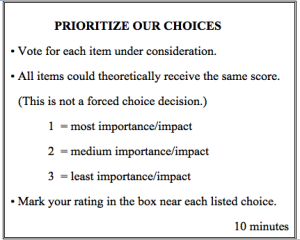“Our group is usually able to generate a list of goals and actions very easily. But after our meetings, we find that we are over our heads with too much extra work. As a result, nothing gets done. Is there a technique that will help us prioritize our ideas so that we spend our time on only the most important issues?”
#6 Nominal Prioritization
What is Nominal Prioritization?
Nominal Prioritization is a technique for measuring and thereby identifying the priority of issues, decisions, or action plans.
The demands placed on organizations are such that not all issues can be dealt with equal consideration. Some issues are simply more important to a group or organization than others and need to be given top priority.
Nominal Prioritization quickly and accurately reveals a meeting group’s priorities.
When to Use Nominal Prioritization
- When the group cannot accomplish everything and must set priorities
- After a list of goals or objectives has been created, and priorities must be established
How to Use Nominal Prioritization
1. After brainstorming a complete list of issues, ideas, goals, or actions, ask your meeting group for help in prioritizing these choices.
NOTE: All choices must be visually displayed to the group on chart paper. Be sure to create enough voting space for each choice.
Ask each person to rank each item under consideration using the following ratings:
1 = most importance and impact
2 = medium importance and impact
3 = least importance and impact
All choices can theoretically be given the same rating. This is not to be considered a forced ranking decision. Use the chart below as a visual aid for your instructions.
NOTE: You could also ask participants to give their rankings by private ballot or by electronic voting.
NOTE: Remember that you should also vote unless you are an outside, neutral facilitator.
2. After everyone is finished with their ratings, determine the average of each choice by adding up the scores for that choice and divide by the number of persons voting. Ask the group to help you with this by delegating some of the options to a few participants. Ask them to round to the nearest tenth. For example, 1.67 becomes 1.7 and 2.23 becomes 2.2.
NOTE: Be sure that each group writes the average or mean for each choice large enough to be seen by everyone in the group.
NOTE: If your group doesn’t have phones with calculators on them, bring a few hand held calculators to distribute for use.
3. Ask the group for their reactions to the prioritized rankings.
4. Ask the group to agree on how to prioritize the issues based on the results of the rating process. You might ask, for example, “What decisions seem logical based on the results of this exercise?” “To what level of priority should we seek to achieve? (Only issues with group priority ratings of 1., 1.5, etc.)” “Which options should we choose?”
NOTE: Most groups will drop the items with the lowest ratings, or put them aside for discussion at a later date. Allow time for lobbying if necessary and decide as a group how to handle any issues of disagreement.
5. Create action plans for all issues selected by the group as priorities.
In Summary:
Nominal Prioritization is a technique for prioritizing the choices that are facing a meeting group.
1. After brainstorming a complete list of choices, ask the group to prioritize their choices based on the ratings illustrated above.
2. After the voting, determine the average score for each choice.
3. Ask the group for their reactions to the results of the exercise.
4. Prioritize the issues based on the ratings.
5. Create action plans for all items chosen as priorities.
———————-
NOTE: If you would like to receive e-mail notification when I post additional techniques, please sign up through this link. http://eepurl.com/KILan You may unsubscribe at any time.
You will find my book Mission Critical Meetings: 81 Practical Facilitation Techniques on Amazon.
